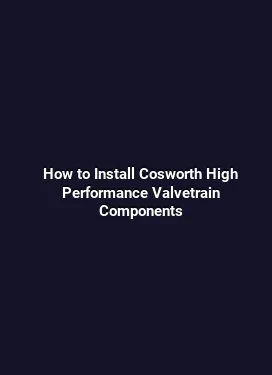Stroker Kit Installation Guide for Chevrolet LS3 Engine Build: Engine Management & Tuning
Transforming an LS3 platform with a stroker kit is about more than increasing displacement; it demands a holistic approach to engine management, fueling strategies, and ignition control. This guide dives into the practical, data-driven steps that maximize performance, reliability, and drivability when pairing a stroker kit with the LS3 family. From choosing the right ECU parameters to implementing real-time tuning practices, informed decisions here translate into tangible gains on the street and at the track.
Foundations of Engine Management for a Stroker LS3

Displacement growth changes the engine’s volumetric efficiency, air-fuel balance, and combustion dynamics. A stroker LS3 typically introduces higher torque at lower revs, shifts the powerband, and alters exhaust backpressure. These shifts necessitate a refined approach to engine management that respects the newer torque curve while protecting the engine under load. A well-considered strategy begins with data-driven mapping, a tailored fuel strategy, and a robust ignition plan that accounts for fuel quality, altitude, and ambient temperature.
Key components of the management strategy include a capable ECU or standalone engine control system, reliable sensors, and a clean interface for data acquisition. A modern fuel-injection system paired with a wideband oxygen sensor allows precise air-to-fuel ratio control across the engine’s operating envelope. In a stroked LS3, maintaining stoichiometry during high-load conditions is crucial for avoiding detonation and minimizing piston or ringland stress. Implementing transients and cruise models that reflect actual driving conditions ensures responsive throttle behavior and consistent idle stability.
Displacement-Driven Parameter Shifts

With increased displacement, volumetric efficiency tends to improve at midrange, but peak VE can shift. Mapping VE curves to reflect this change is essential. Adjust fuel trims to establish a safe, lambda-targeted base, then use feedback corrections to fine-tune under load and during rapid throttle transitions. In engines with longer strokes, piston dynamics and dwell times at top dead center change, which can influence ignition timing requirements. A staggered timing strategy, where more advanced timing is applied at mid-range RPMs with careful control near redline, often yields a more favorable torque curve without compromising safety margins.
Sensor placement and calibration become increasingly important as displacement rises. Ensure intake air temperature, ambient pressure, and manifold pressure readings are free from bias. A high-quality MAF or MAP sensor setup, paired with a reliable intake tract, helps prevent fuel trims from drifting during acceleration or deceleration, keeping the tune consistent across shifts and gears.
Fueling Strategy for a Stroker LS3
A stroker LS3 typically benefits from a richer mixture at part and full load compared to a stock configuration, due to altered air mass flow and cylinder pressure profiles. A robust fueling strategy uses a combination of base fueling, dynamic fuel trims, and injector sizing that aligns with the engine’s new breathing characteristics. The aim is to maintain stable idle, smooth mid-range response, and a healthy wideness of the air-fuel ratio window under boost or high-load scenarios.
Base fueling starts with accurate injector sizing and flow data, ensuring the ECU can deliver the required mass of fuel for the revised displacement. Using a wideband O2 sensor during the initial runs is essential to map the target lambda across RPM and load. During tuning, enable closed-loop operation at idle and light cruising to establish a consistent baseline, then transition to open-loop or blended modes under load to preserve repeatability when high throttle is demanded.
Boost Considerations and Ethanol Compatibility
When a stroker kit is combined with forced induction, fueling becomes more sensitive due to increased cylinder pressure and temperature. A staged approach to boost, with progressive timing and fuel ramping, helps manage detonation risk. Ethanol blends, common in performance fuels, alter stoichiometry and cooling effects. If ethanol is present, recalibrate target air-fuel ratios and verify fuel system capability to maintain stable supply under boost. Top-tier builds leverage ethanol-compatible fuel systems and corrosion-resistant components to sustain long-term reliability.
For naturally aspirated strokers, focus on nozzle-to-cylinder matching, reliable injector spray patterns, and precision fuel control at high RPM. In every case, logging fuel trims, injector duty cycle, and MAF/MAP readings during WOT runs reveals opportunities for refinement and confirms the tune’s safety margins.
Ignition Timing and Detonation Control
Ignition timing is the pulse that sets the engine’s efficiency and power envelope. With a stroked LS3, the combustion chamber dynamics change, and so does the optimal timing curve. A prudent approach is to establish a conservative, flexible baseline timing map that adapts to variances in fuel quality, ambient temperature, and atmospheric pressure. Advanced strategies may utilize dynamic timing adjustment, where the ECU advances timing under consistent load and moderate RPM but retards timing in response to knock or rapid temperature rises.
Detonation control remains a critical safety feature. Modern ignition systems and engine management frequently rely on knock sensing, fast octane sensing, and predictive algorithms to prevent detonation before it starts. When tuning, perform conservative pulls on timing at low RPM under boost, verify with a controlled knock test, and watch for abnormal cylinder-to-cylinder variation. A robust knock control system allows more aggressive mapping under safe conditions, but a failure to monitor knock can lead to long-term engine damage.
Ignition System Choices
A large-displacement LS3 benefits from a capable ignition system with strong spark energy and reliable ignition coils. High-energy coils and optimized spark plug gaps help maintain flame front stability under higher cylinder pressures. Ensure coil-near-plug or coil-on-plug configurations are mechanically sound and electrically isolated to prevent EMI interference. Additionally, maintain a clean ignition wiring harness to reduce parasitic resistance that can erode timing accuracy at high RPMs.
In practice, developers often pair spark plugs with heat ranges matched to the engine’s fueling and boost strategy. A slightly cooler plug can ward off pre-ignition in boosted configurations, while ensuring the plug sequencing and gap are compatible with the ECU’s control strategy. When switching to aggressive timing strategies, re-check plug cooling efficiency and verify that external heat management remains effective under load.
Data Acquisition, Telemetry, and Real-Time Tuning
Good tuning relies on rich data and disciplined analysis. A modern engine management solution provides real-time telemetry, logging, and robust dashboards for viewing critical metrics like air-fuel ratio, knock events, cylinder pressure estimates, and throttle response. The use of a wideband O2 sensor, a high-resolution MAP/MAF sensor, and a reliable RPM signal is essential for building repeatable tunes across different conditions.
Data logging should cover a broad spectrum of operating conditions: idle, light cruise, wot (wide-open throttle), and transitions between gears. Post-run analysis reveals how the engine behaves during peak torque production, enabling more precise timing and fueling adjustments. When possible, correlate sensor data with chassis dyno results or ride-along data to translate engine behavior into practical, street- or track-friendly adjustments.
Closed-Loop vs Open-Loop Behavior
Engines with stroker kits often benefit from a dual-mode approach. Closed-loop operation helps maintain idle and cruising efficiency, while open-loop mode ensures predictable response during high-load scenarios where the sensor feedback loop might lag behind rapid changes. The tuning discipline involves ensuring smooth transitions between modes and preventing sudden AFR swings that could trigger misfires or roughness.
Real-world applications emphasize the importance of properly calibrated transient response, including accelerator pedal mapping, throttle by wire calibration, and torque management strategies that keep drivetrain behavior linear and controllable under power. A carefully tuned engine management strategy yields consistent performance, improved fuel economy under normal driving, and predictable responses when the boost or displacement demands are high.
Airflow, Intake, and Exhaust Considerations
Airflow is the lifeblood of a stroked LS3. A stroker kit alters the torque curve by increasing displacement, but the intake and exhaust system must be capable of delivering the additional air and expelling the combustion byproducts efficiently. Upgrades to the intake manifold, throttle body, and high-flow intake piping can reduce restriction, particularly at mid-to-high RPM. On the exhaust side, a tuned header and exhaust system that reduces backpressure while maintaining scavenging efficiency helps maximize the gains anticipated from the stroker build.
Engine management must reflect these changes by adjusting MAF scaling, VE maps, and intake air temperature compensation. Accurate mass air measurement is critical to avoid fueling drift, especially when the engine breathes more aggressively. This is where sensor calibration and calibration constants for new hardware play a central role. The goal is to maintain a stable, repeatable air-fuel relationship across the engine’s entire operating range, even as throttle, rpm, and load vary rapidly.
Calibration Practices for Enhanced Breathing
A practical calibration approach involves incremental testing: map baseline fueling and timing with the stock intake and exhaust to establish a reference, then progressively introduce the stroker components along with intake and exhaust upgrades. After each hardware change, re-baseline through a controlled set of runs, starting from idle, advancing to light cruising, then performing WOT pulls. This method ensures each adjustment has a clear, isolated impact on the tune, reducing the risk of cascading errors.
Additionally, consider the role of altitude and ambient temperature. A versatile tune employs temperature compensation routines and altitude correction, maintaining consistent performance across a range of operating environments. Consistent data collection across multiple sessions helps identify drift caused by environmental changes versus hardware-induced shifts, enabling more precise finalization of the tune.
Practical Roadmap: From Installation to Fine-Tuning
A robust path from stroker installation to a fully tuned, street-ready engine involves a sequence of deliberate steps. Start with verifying mechanical integrity: torque-to-yield fasteners, correct gasket material, and reliable oiling for increased displacement. Next, install a compatible ECU or standalone system with adequate processing power and sensor support. Then, configure the base map with safe targets for fuel, timing, and boost (if applicable), followed by staged testing to validate driveability and reliability.
During the tuning phase, adopt a methodical approach: establish a calm baseline, log key metrics, and adjust in small increments. Prioritize engine safety by ensuring there is sufficient fuel delivery and a reliable knock control system before pushing towards peak power. Finally, document all changes, trace improvements with data, and maintain a consistent maintenance schedule to safeguard the build’s longevity and performance momentum.
Final Tips for Consistency and Longevity
Keep sensor health as a priority. A failing O2 sensor, degraded MAP sensor, or irregular throttle position data can derail even the most carefully engineered tune. Regularly verify ignition components and battery health, as voltage dips can impact timing accuracy. If you plan to run high-cylinder-pressure scenarios, consider a robust cooling strategy, including oil cooler upgrades and an auxiliary radiator to maintain optimal operating temperatures under sustained boost or high-load tests.
Engage in a disciplined maintenance cycle and avoid late-night, ad-hoc tuning sessions. A reliable setup relies on repeatable measurements and a calm environment where data interpretation remains objective. With a thoughtful, data-driven approach, a stroked LS3 build can deliver predictable power delivery, improved throttle response, and a durable, high-performance driving experience.






